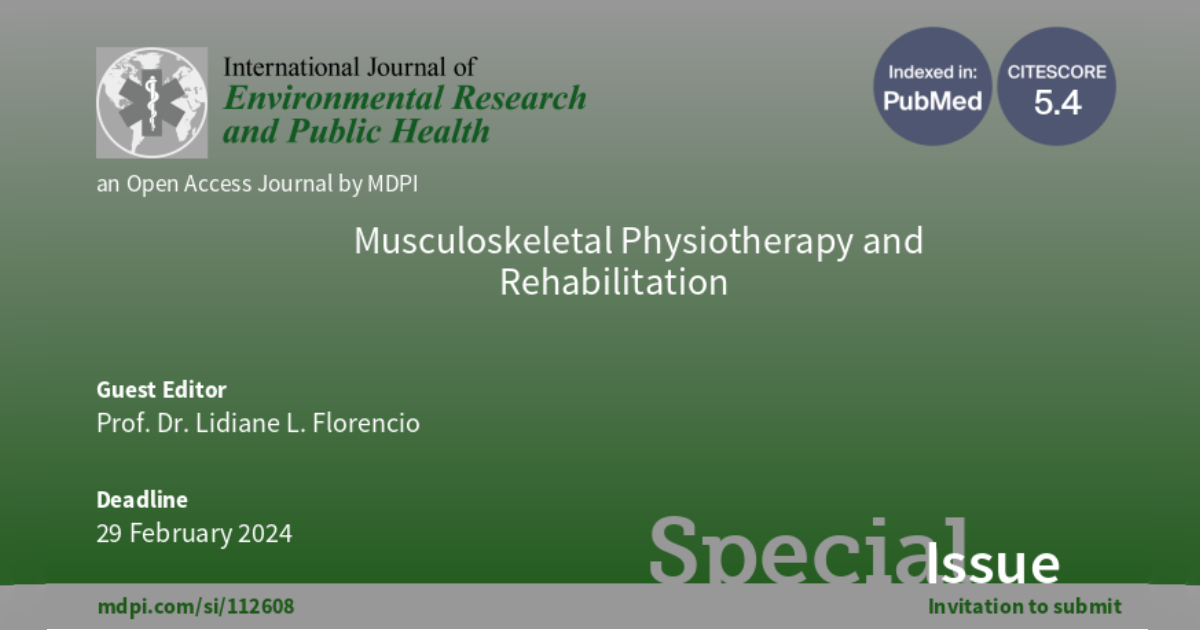Musculoskeletal Physiotherapy and Rehabilitation
A special issue of International Journal of Environmental Research and Public Health (ISSN 1660-4601).
Deadline for manuscript submissions: closed (29 February 2024) | Viewed by 17397

Special Issue Editors
Interests: pain; chronic pain; rehabilitation; exercise therapy; manual therapy; electromyography; measurement properties; applied kinesiology
Special Issues, Collections and Topics in MDPI journals
Interests: headache; postural control; musculoskeletal disorders; pain; rehabilitation; temporomandibular disorders
Interests: musculoskeletal pain; headache disorders; chronic pain assessment and management; vestibular symptoms; gait and balance analysis; physiotherapy interventions
Special Issues, Collections and Topics in MDPI journals
Special Issue Information
Dear Colleagues,
We invite you to contribute to our Special Issue, “Musculoskeletal Physiotherapy and Rehabilitation”, which aims to enhance evidence about the assessment and treatment strategies addressed to musculoskeletal conditions and its repercussions on patients’ lives.
Musculoskeletal disorders are among the most disabling conditions worldwide. It is generally related to chronic conditions that affects sensorial, physical, and social dimensions. This Special Issue welcomes well-designed and good-quality studies about musculoskeletal disorders, their impact, and treatment. We also welcome studies related to musculoskeletal function and the measurement properties of the instruments used in their assessment are important because it would help us to trust in the data obtained during our assessment and to rationalize the treatment approach. Studies using quantitative, qualitative, mixed-methods or systematic reviews with or without metanalysis are considered.
You may choose our Joint Special Issue in Healthcare.
Prof. Dr. Lidiane L. Florencio
Prof. Dr. Carina Ferreira Pinheiro-Araujo
Prof. Dr. Gabriela Ferreira Carvalho
Guest Editors
Manuscript Submission Information
Manuscripts should be submitted online at www.mdpi.com by registering and logging in to this website. Once you are registered, click here to go to the submission form. Manuscripts can be submitted until the deadline. All submissions that pass pre-check are peer-reviewed. Accepted papers will be published continuously in the journal (as soon as accepted) and will be listed together on the special issue website. Research articles, review articles as well as short communications are invited. For planned papers, a title and short abstract (about 100 words) can be sent to the Editorial Office for announcement on this website.
Submitted manuscripts should not have been published previously, nor be under consideration for publication elsewhere (except conference proceedings papers). All manuscripts are thoroughly refereed through a single-blind peer-review process. A guide for authors and other relevant information for submission of manuscripts is available on the Instructions for Authors page. International Journal of Environmental Research and Public Health is an international peer-reviewed open access monthly journal published by MDPI.
Please visit the Instructions for Authors page before submitting a manuscript. The Article Processing Charge (APC) for publication in this open access journal is 2500 CHF (Swiss Francs). Submitted papers should be well formatted and use good English. Authors may use MDPI's English editing service prior to publication or during author revisions.
Keywords
- rehabilitation
- exercise therapy
- manual therapy
- measurement properties
- applied kinesiology
- pain
- chronic pain
Related Special Issue
- Musculoskeletal Physiotherapy and Rehabilitation in Healthcare (3 articles)







